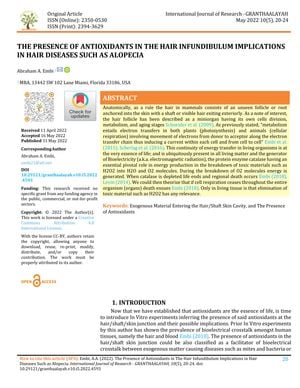TLDR Antioxidants like catalase are important for preventing hair loss conditions like alopecia.
The document discusses the role of antioxidants, specifically the enzyme catalase, in the hair infundibulum and its implications for hair diseases like alopecia. Catalase is crucial for breaking down hydrogen peroxide (H2O2) into water and oxygen, a process that generates energy and is essential for cellular metabolism and bioelectricity. The depletion of catalase can lead to cell death, suggesting its importance in maintaining hair health and preventing conditions such as alopecia. The study highlights the significance of antioxidants in the hair follicle's metabolic processes and their potential impact on hair diseases.
 7 citations
,
November 2018 in “International Journal of Research -GRANTHAALAYAH”
7 citations
,
November 2018 in “International Journal of Research -GRANTHAALAYAH” Human hair's biomagnetic fields can affect blood cell clumping and coagulation.
 1 citations
,
August 2018 in “International Journal of Research -GRANTHAALAYAH”
1 citations
,
August 2018 in “International Journal of Research -GRANTHAALAYAH” Hair follicles emit electromagnetic fields, useful for medical applications.
 4 citations
,
July 2018 in “International Journal of Research -GRANTHAALAYAH”
4 citations
,
July 2018 in “International Journal of Research -GRANTHAALAYAH” Antioxidants, like catalase, are crucial for keeping hair follicles alive.
 759 citations
,
February 2009 in “Current Biology”
759 citations
,
February 2009 in “Current Biology” Hair follicles are complex, dynamic mini-organs that help us understand cell growth, death, migration, and differentiation, as well as tissue regeneration and tumor biology.

Good nutrition may help prevent premature hair graying.
 June 2025 in “Clinical Cosmetic and Investigational Dermatology”
June 2025 in “Clinical Cosmetic and Investigational Dermatology” Gray hair can potentially be managed or reversed with treatments that boost melanin production and address nutritional deficiencies.
 30 citations
,
July 2017 in “BioEssays”
30 citations
,
July 2017 in “BioEssays” Activating NRF2 might help treat hair disorders by improving antioxidant defenses.
 126 citations
,
January 2009 in “International Journal of Trichology”
126 citations
,
January 2009 in “International Journal of Trichology” Oxidative stress contributes to hair graying and loss as we age.
 75 citations
,
January 2009 in “International journal of trichology”
75 citations
,
January 2009 in “International journal of trichology” Hair grays due to oxidative stress and fewer functioning melanocytes.









